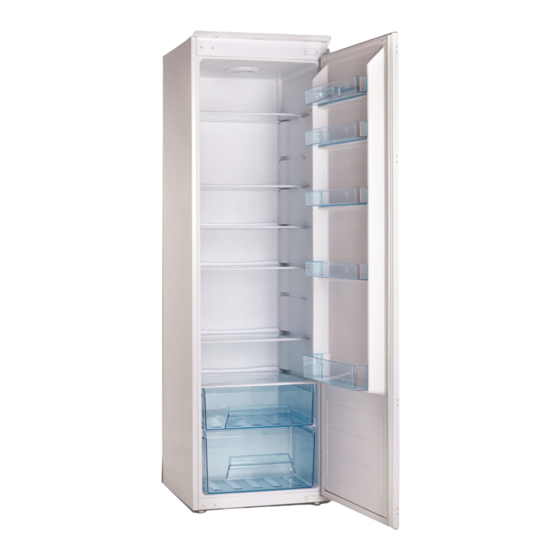
Table of Contents
Advertisement
Instruction Manual
Built in Larder Fridge
Instruction Manual
RITL395A+
Contents
Cautions---------------------------------------------------------------------------------------------1~2
Diagram---------------------------------------------------------------------------------------------3
Preparation-----------------------------------------------------------------------------------------3
Operation-------------------------------------------------------------------------------------------4
Instruction------------------------------------------------------------------------------------------5~7
Defrosting, cleaning and de-commissioning----------------------------------------------8~9
Trouble shooting---------------------------------------------------------------------------------10
Advertisement
Table of Contents

Subscribe to Our Youtube Channel
Summary of Contents for Nordmende RITL395A+
-
Page 1: Table Of Contents
Instruction Manual Built in Larder Fridge Instruction Manual RITL395A+ Contents Cautions---------------------------------------------------------------------------------------------1~2 Diagram---------------------------------------------------------------------------------------------3 Preparation-----------------------------------------------------------------------------------------3 Operation-------------------------------------------------------------------------------------------4 Instruction------------------------------------------------------------------------------------------5~7 Defrosting, cleaning and de-commissioning----------------------------------------------8~9 Trouble shooting---------------------------------------------------------------------------------10... -
Page 2: Cautions
Cautions Disposal of the old appliance Before disposing an old appliance, please make sure it’s inoperative and safe. Unplug the appliance and remove or destroy all of the springs, latches, or bolt-locks in order to avoid the risk of child entrapment. It must be noted that the refrigeration system contains insulating gases and refrigerants, which require specialized waste disposal. -
Page 3: Cautions
Cautions... -
Page 4: Diagram
Refrigerator Diagram-- Preparation 1.Shelves 2.Vegetable and fruit tray 3.Temperature Controller 4.Egg tray 5.Bottle racks This diagram may vary slightly with the layout of the refrigerator you have just purchased due to technical improvements. Preparation Unpacking Remove all packing materials. Check attachments and materials Checking should be conducted with reference to the Packing List. -
Page 5: Operation
Operation Starting the refrigerator After connecting to the power supply, turn the temperature controller clockwise from position 0 to any position between 1 and 7 to start the refrigerator. The refrigerator compressor will stop when the temperature controller is at position 0. Adjusting the temperature: The temperature inside the refrigerator is adjusted by turning the temperature controller. -
Page 6: Instruction
Instructions Cold storage is for short-term food storage or for daily consumption. Although the temperature in most parts of the cold storage compartment can be regulated between 0 food storage is not recommended. Cold storage and 10 degrees Centigrade, extended periods of should only be used for short-term storage. - Page 7 Instructions * Do not store excess quantities or weights of food; food should be stored with spaces in between for better storage results. Never overload shelves, as they may collapse under excessive loads. * Food to be stored should be sorted according to consumer requirements. Food consumed daily should be placed in the most convenient area, this will minimize opening periods for the door.
- Page 8 Instructions Instructions for food storage *Storage period will be extended if vegetables are placed with their roots towards the cold source. *Leaves of carrots or turnips should be removed before storage. *Put a wad of tissue on the bottle holder before placing bottles on it so that later cleaning is easier *Onions, garlic, ginger, water chestnuts and other root vegetables should not be stored in the refrigerator,as these foods are suitable for long-term storage at...
-
Page 9: Defrosting, Cleaning And De-Commissioning
Defrosting-Cleaning -De-commissioning Defrosting the cold storage compartment The cold storage compartment is designed for automatic defrosting. Frost formed on the back wall will melt and flow via the drainpipe to the evaporating container over the compressor on the back of the refrigerator, where the heat generated by the compressor will evaporate the water. -
Page 10: Power Failure
Defrosting-Cleaning -De-commissioning Power failure Even in summer, food can be stored in the refrigerator for a few hours after a power failure. * Don’t put additional food into the refrigerator during a power failure. * Avoid opening the door during power failures *If prior notice of a power failure is given, make some ice and put it in a container in the top of the cold storage compartment. -
Page 11: Trouble Shooting
Questions and Answers Events below are not problems: * The temperature of the refrigerator and the compressor will rise and the compressor will run for comparatively longer periods when the refrigerator is first started. * Wipe water drops on the external surface of the refrigerator with a soft cloth. * When the refrigerator is opened frequently or stay open too long in humid seasons, the cavity will be dampened. - Page 16 Positioning and installing the appliance 1. Once the appliance has been unpacked, check the main voltage is the same as that indicated on the rating plate. 2. If the door opening direction is as required, go to Point 3. Otherwise, reverse the position of the hinges.














Need help?
Do you have a question about the RITL395A+ and is the answer not in the manual?
Questions and answers